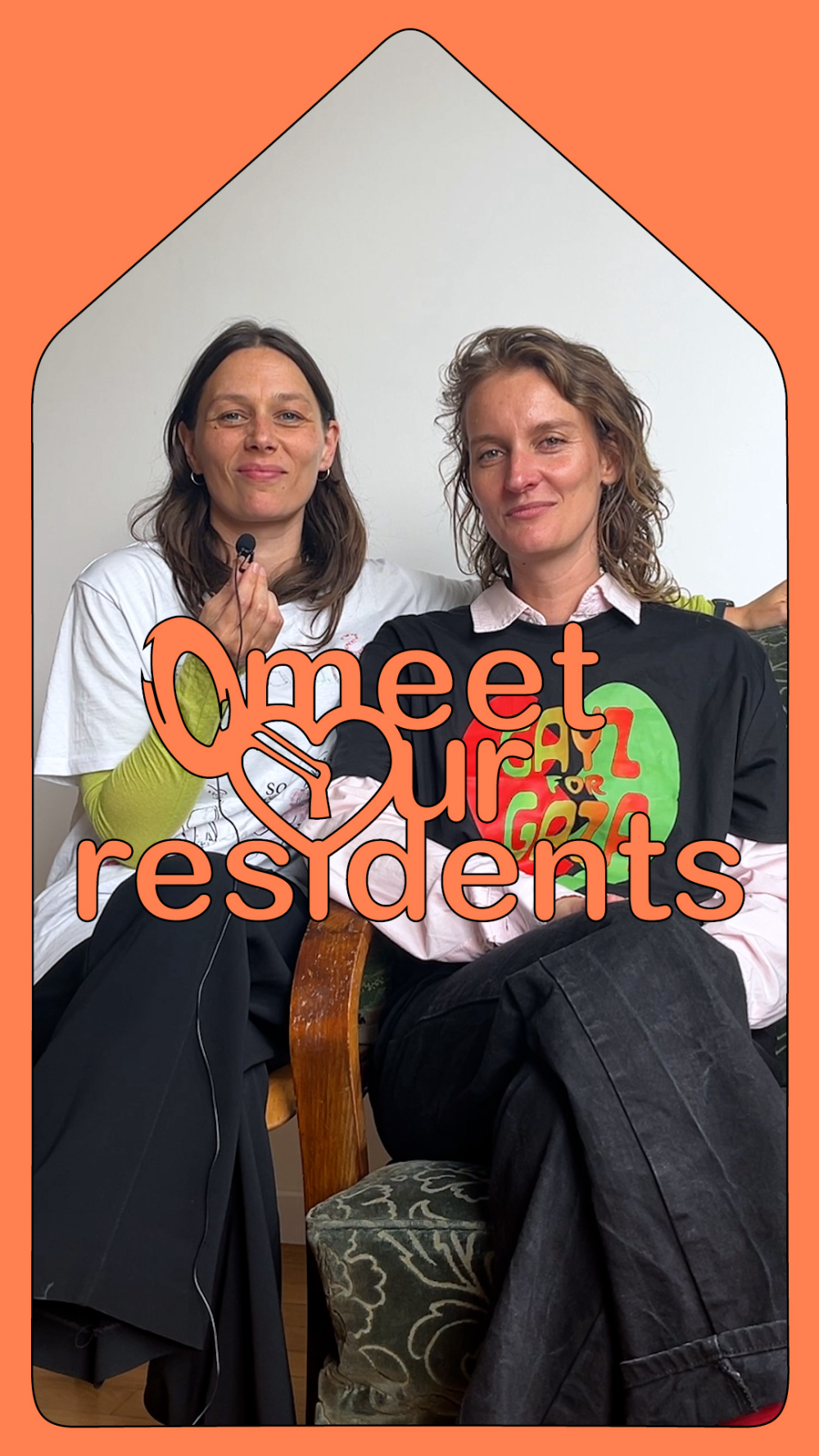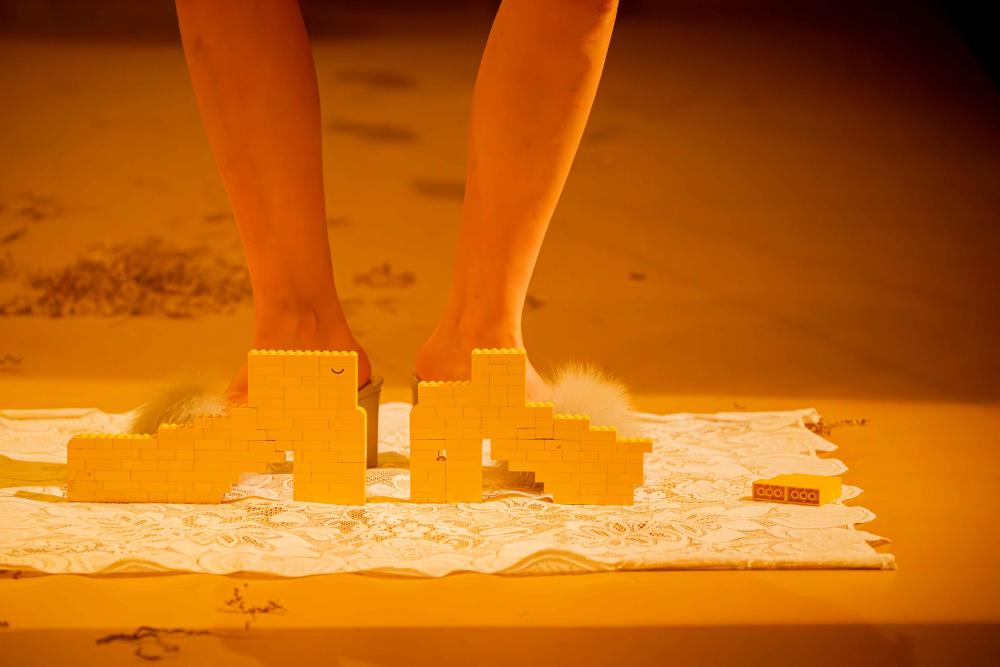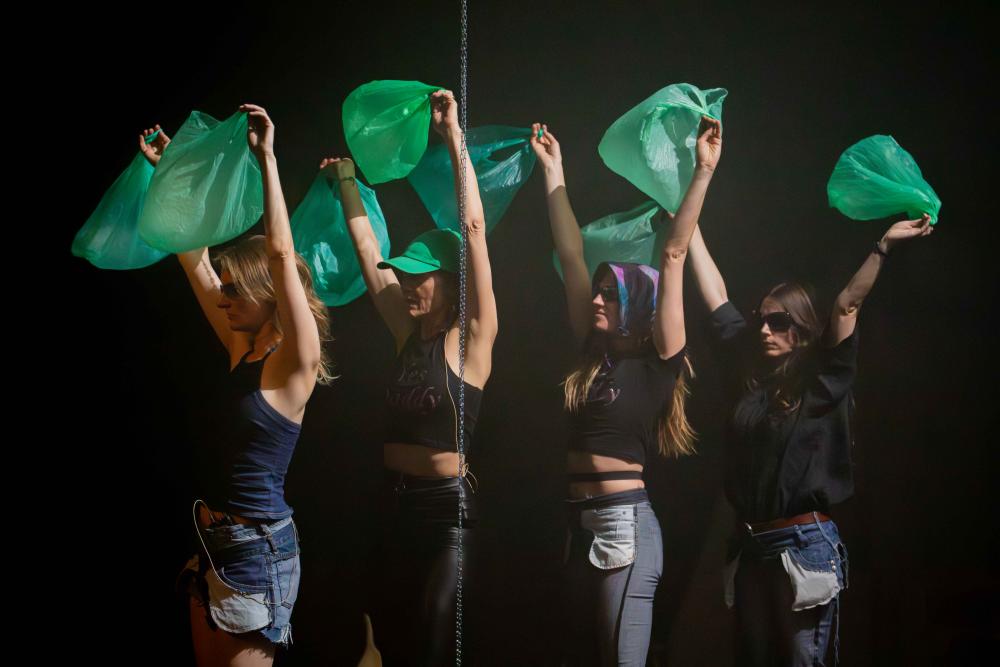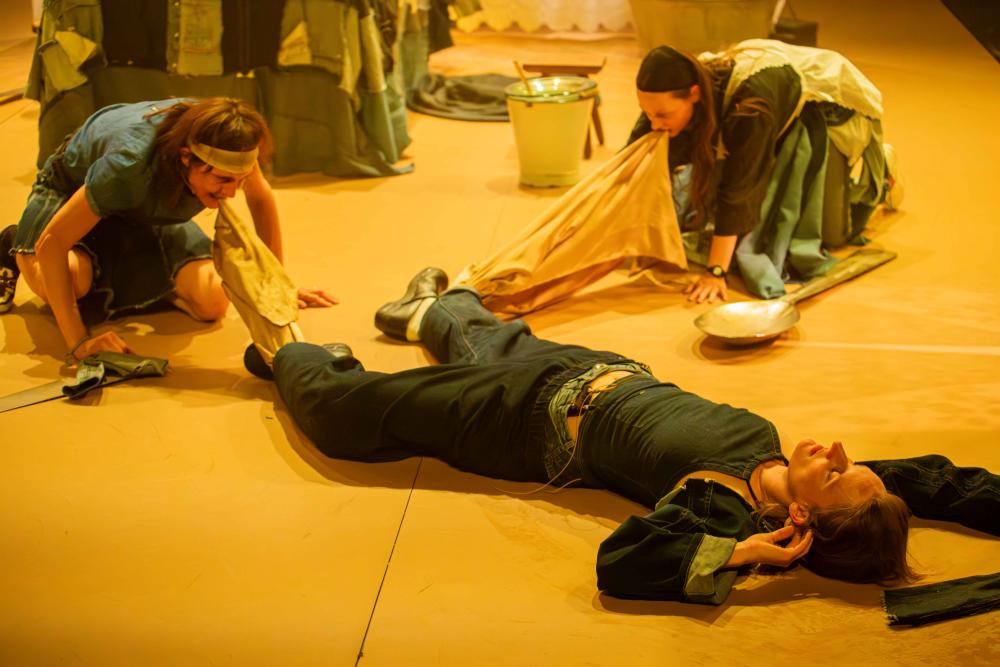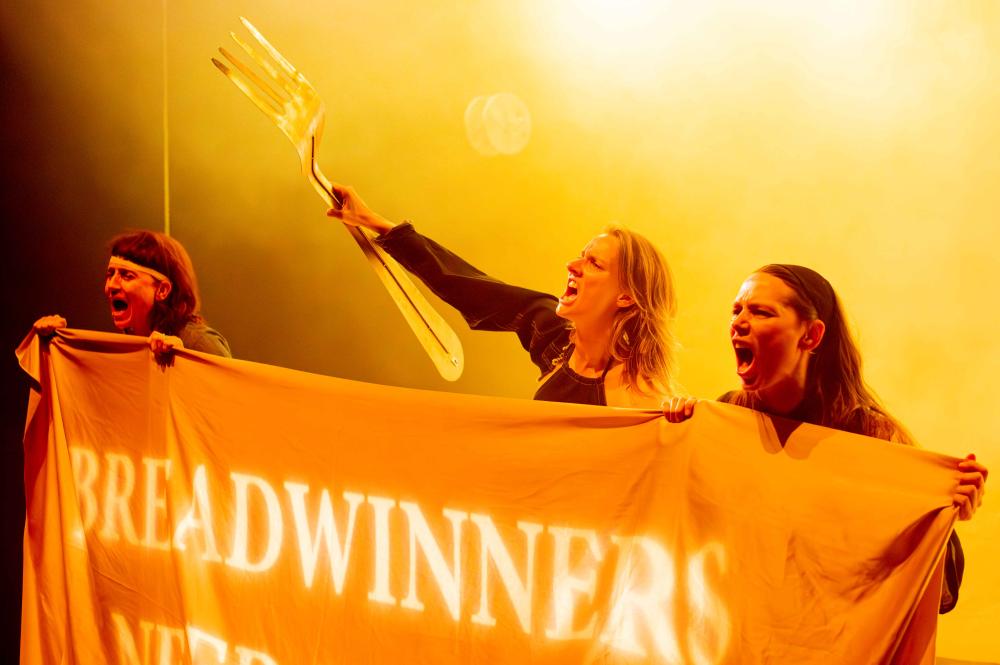A feeling of ecstasy and melancholy
An interview with buren
In late 2012, Oshin Albrecht and Melissa Mabesoone co-founded buren collective. Buren functions as a noun and a verb; an umbrella term for their practice and a modus operandi. Through performance, video, tekst, objects, photography, and installation, they move between ideas of community, domesticity, gender, (art) history and neoliberal fantasies. Since 2023, buren collective has been artist-in-residency at Kaaitheater. We met up for an interview two weeks before the Brussels premiere of shoe/farm – a family business in BRONKS. We talked about their residency, the meaning of ‘beyond the black box’ and how it was to suddenly not be two but four on stage.
Interview by Mara Ittel & Dagmar Dirkx
You can find the video of the interview here.
How is your residency in Kaaitheater going? What are you currently working on?
Melissa Mabesoone: First of all, it was very nice that we could extend our relationship with Agnes (Quackels) and Barbara (Van Lindt). We met Agnes in 2012 when buren was born, in BUDA Kortrijk. It was nice to continue talking with them, and at the same time have our practice based both in Brussels and Ghent. To have a dialogue between these cities. Of course, Kaaitheater is also renovating. But it was very interesting to see how this moving in and out of places influenced our practice.
Oshin Albrecht: In the meantime, we’ve published a book. It’s a graphic novel, based on our performance SPARE TIME WORK. Since it’s a very musical performance, and since we’ve always wanted to make a record, the book now has the shape of a record. It’s made in collaboration with Het Balanseer. We’ve presented it at VROOM where we dit a little installation and a session where we sang the lyrics and text of the book. Actually, for the moment we are working on a real record. It will be based on the songs from SPARE TIME WORK and from our new piece, shoe/farm – a familiy business.
Can you introduce your new piece shoe/farm – a family business ?
MM: Okay. With or without the guitar? (laughs)
OA: We also need drums. It's a very musical performance. You can imagine now that there's a guitar in the background and a bass guitar.
MM: Maybe some drums made of shoeboxes. Heels are clicking, and you see different figures. The world in which you have now arrived is a shoe farm, which is a fictitious family compan. A family business in which shoes are farmed.
OA: Exactly. Everybody in the farm is wearing jeans. Sometimes reversed, sometimes not reversed.
MM: There are different workhorses… But maybe it is important to say that the piece is derived from the places where we grew up. Oshin grew up in a shoe shop, and I grew up on a farm. We wanted to do something with our background and how we grew up. There are ideas about work, and about spare time that we explored in SPARE TIME WORK. But now we wanted to go more into some specific spaces. In the prelude version we showed last year, shoe/farm – a prelude, we did a kind of exploration of the world of the shoe and the world of the farm. But now we really start from the contamination, the morphing of the two. So this becomes a fictional company, a fictional family, a shoe farm, a family business. This means we are with four people on stage. The piece reflects the way of production changed through time. We go from pre-industrial (more or less), to late capitalism. Sort of. From things that are made by hand and with a close relationship to nature to how production changes in times of internet shopping.
OA: And also how the functioning of a shop changed over time. What is for instance servitude? And what does it mean in relationship to being an heir in a family? While also being an employee in a family business? These are the questions we try to explore in this performance.
MM: And also what it means to choose your own path…while you also have…
OA: ...privilege.
MM: Yeah, or the opportunity or the choice that this question is there. Do you want to take over the family business? That’s already such a very specific question. For the piece, we work together on stage with Katja Dreyer and Léa Dubois. Katja is half-German, half-Slowakian (she also made a piece about it that was on view in Kaaitheater) and Lea is Belgian, but from the French speaking side. These backgrounds and also their own family relationships influenced the piece as well.
How was it for you to work with 4 people, instead of the two of you? We can imagine you have built certain ways of working over the years?
OA: Well, I just had a baby, so that was already a bit of a different situation for us. But it was super interesting to see how to translate our universe, our way of using texts, our way of building a scene…to other people. Because it’s very rhythmical, the way we work. There’s some kind of mutual understanding between us that has formed over the years. So we were looking for ways to translate this understanding. Of course, this process is still taking place. You don’t just do that in 3 or 4 months. For us, it was good to have the shoe/farm – a prelude. It was a beautiful base to start from. We also did improvisations with the performers, so that they could also bring in their imagination. Also physically. Then, we continued building from there on.
MM: I think it's very nice. Of course, it’s challenging too. It’s the first time we really made a piece for the black box with a group. You start to realise the weight of your work, because you are working with other people. Like Oshin said, there’s this unspoken language we’ve developed over the years. Sharing this with others also makes you become aware of the things you find important. Like a sense of humor, or a performance style. Very often it’s very thin lines that are the most challenging to translate to other people.
How did you find the two performers?
OA: We were interested in Katja Dreyer, because we had seen her in other work and were interested in her way of dealing with personal history. Also the political side of personal history. We thought that would be a good addition to this piece. Normally, we were going to work with Calvin Carrier, but our agendas didn’t match anymore. So we decided to organise auditions and that’s when Leah showed up. We really had a click with her.
MM: Because first we though maybe there’s some similarities in the appearances of Calvind and me and Katja and Oshin. Like a ‘family’ resemblance. But during the auditions, we focused more on energy and jumped into imagination. We like it when people can very quickly go on board when we put something on the table. Léa’s background as a dance and her humor really added. It was the first time we created the piece as an ‘extended family’. It was also nice that both Katja and Léa are parents themselves, for this piece also.
Shoe/farm – a family business is part of Beyond the Black Box. How do you think the piece is challenging ways of being in a black box?
OA: Since we started our collaboration, with been thinking about the importance of working with codes of specific spaces. We try to have this exchange with an environment or a space, move things around a little bit. For shoe/farm – a family business we start with more painterly scenes, where the audience is really ‘consuming’ what they see. The idea of the shop, of consuming is heightened. At the same time, we try to engage the audience at certain moments. Because our work is very musical, it has has this entertaining factor. The idea of consumption in relation to the performing arts is something that’s part of our work for a while.
MM: From the moment we started working in the black box, we didn’t take for granted that we were there. We were very aware of the power relationship that goes both ways. The audience pays a ticket and it ready to be – like Oshin said – entertained. Then there’s also the power relationship that you have as a creator and performer towards the audience. You can decide what’s being seen. And how. From which side. Like scenography-wise. We thought that was really interesting. But also: if you can have the stage, what do you want to do with it, what do you say?
OA: Someone once said we use the stage as a critical playground. I think it’s a good quote. Beyond the Black Box is usually talked about as a mix of forms, of genres. But maybe it can also be what happens beyond het black box when you leave the theatre? When you go home and walk through the streets and see the shopping windows? How you start thinking about your own family? Etcetera…
How do you see beyond the black box in relationship to the art world itself? You speak about homegrown and self-made – which relates of course to the worlds of the shoe shop and the farm – but how do these terms apply to you as artists?
MM: I realised more and more when we describe our work, we often talk about our visual background. Which is mostly a study of four years, while we’ve been working as professional artists for more than ten. I guess it’s more of an entry point. I think, for instance, when we describe our work you can’t say it’s muiscal, or theatre, or dance….it’s not, because it’s all of it. But as artists we find it really important to stretch these concepts, to be playful and challenge ourselves what’s possible within these boundaries. And then hope that you’ll find people who support that practice along the way. Because that is the most challenging in a way. Often, when you cannot be put ‘into a box’, you can’t be programmed or get funding so easily.
Do you have a specific routine before you go on stage or before a show like you, some kind of ritual or something?
OA: Sleep! Ten minutes, a power nap.
MM: We also like to eat early. A lot of performers eat afterwards, but we like to eat around 5 or 6pm. I also like to go out, put some music in my ears and dance. For instance on a parking lot. Sometimes we have a little dance together, so we can have a soundcheck at the same time. And we pinch each other before going on stage. Have fun. Toi toiiii.
How do you want the audience to leave your piece, or what do you hope to give them?
OA: A feeling of ecstasy and melancholy at the same time.
MM: Yeah, it’s like we sing:
(together)
We're going to go to the back of the store
To find what you're looking for.
Find us in every city.
Kind regards, the customers committee.
